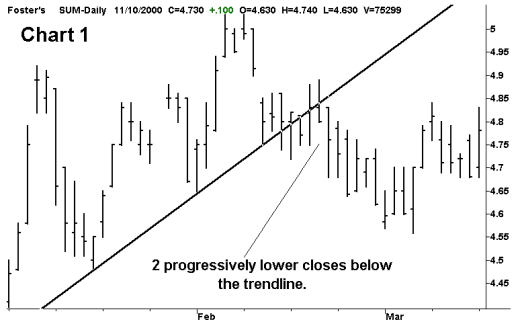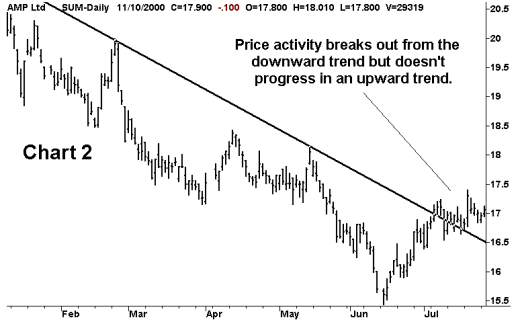- Active Investing - what is it?
- All Weather Trading Plan using Complex Theory (Parts 1 - 4)
- Asset Management (Parts 1 - 4)
- Back Testing
- Breaking out from consolidation
- Breakout trading in all market conditions
- Charting in a Nutshell
- Children of the Bear
- Fibonacci and the Golden Ratio
- Going Public
- Hull Moving Average
- MACD Breakout Trading (Parts 1 - 2)
- Making decisions with a Simple Moving Average
- Probability: do you have the stomach for it?
- Profit Taking
- Relative Strength
- Record Keeping
- Risky Business
- Short Selling
- Social Media Bubble
- Switching Gears
- Rate of Return indicator
- Time and Money
- Tools of the Trade
- Trade Warrants (Parts 1 - 4)
- Trading without spending money
- Trendlines
- Triangles
- GMMA's on Weekly Charts
- Writing Custom Indicators
Articles include:
When analyzing either an upward or downward trend it is common to use trendlines. In an upward trend, a trendline is constructed by drawing a line that touches two or more of the most significant lows. The more often the price activity touches the trendline: the more significant the trend. This line provides support to the price action and, when broken by the price activity, indicates that the trend is weakening or may be over. In a downward trend, a trendline is constructed by drawing a line that touches two or more of the most significant highs. The downward trendline provides resistance to the price activity.
A common method of deciding whether or not an upward trend is broken is to watch for two consecutive closes, below one another, below the trendline. This type of exit signal is shown in 'Chart 1' and works well in this example. If the price activity is moving either sideways or downwards then the trade is no longer profitable and an exit is warranted. Note that the effectiveness of this method is largely due to the chartist's ability to place trendlines.

If price activity breaks out of an upward trend then it may begin to move either sideways or downwards. Similarly, when price activity breaks out of a downward trend it can move either sideways or upwards. However, whilst a breakout from an upward trend does signal an exit, a breakout from a downward trend does not signal an entry. 'Chart 2' is an example of an invalid entry signal given by 2 consecutive closes higher than one another, above the trendline. A breakout from a downward trend does not necessarily indicate that the price activity is in an upward trend. Before entering the market the trader must determine whether or not the price activity is in an upward trend.

This mistake may seem very obvious when using trendlines but it is a common mistake made when trading with moving averages. A simple, robust and symmetrical trading method is to enter on 2 consecutive closes above a moving average, a 21 day SMA (Simple Moving Average) for instance, and exit on 2 closes below the moving average. Whilst the exit signal is valid, the entry signal requires further qualification. The moving average must be heading in an upward direction. 'Chart 3' shows an invalid entry and a valid entry; the difference being the direction of the 21 day SMA.
